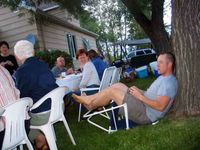
Jim steps up to protect the local travelers at the Inuvik Airport.
Well, I’m back from the end of the world, at least the end of the road… actually there is no road to Tuktoyaktuk (Tuk) so I guess I went beyond. Here is a pictometary with some comment of my adventures where the sun don’t shine (go ahead and make fun).
Before leaving I had an opportunity to spens some time with my Beloved brother, Sis-in law, my God Son and Niece, aren’t they cute!

It was unusual arriving at these remote locations, what was most shocking to me during my first 5 minutes in the Northwest Territories was the similarities between the cab drivers of Inuvik and Toronto. $40.00 for a 5 minute cab ride? Get outa here!
This is an Igloo that is built as a sphere, from what I gathered it was built this way to avoid damage to the foundation when the shifting from the temperature change occurs. It is anchored by a single tie down and rotates as the earth beneath it shifts.

From Inuvik it was off to “Tuk” where the landscape changes from tree lines and different elevations to somewhat flat and treeless with lakes dabbed all across the plains.

There was plenty of rain and gloomy sunless days, but this odd thing appeared beside the base the first day we were there, I guess it was a look at the last bit of natural color we would see for a while. Trust me there was NO RAINBOW in Tuk.

This is the bed I stayed (almost) in, my feet stuck out the bottom and when I shifted at night I almost always nailed the wall. This must have scared the sasquatch looking woman on the other side because it was not uncommon for her to shit her pants (or al least sound like it) when I would move to another position.

Here is the beautiful town of Tuk taken from the end of the Trans Canada Trail.

This monument was dedicated by Queen Elizabeth during a visit to the NWT to mark the end of the trail.

This is a sort of hut used to keep such things as Caribou and Musk ox refrigerated, there is a tunnel that leads below the perma-frost line and provides cold temperatures year round. It is still used today by the local townspeople.

I followed the noise of a pack of dogs to this spot where a local dog sled racer keeps his animals separate from civilization. They were generally quite calm but none had the eyes of a dog I would approach for a cuddle.




As mentioned there are no roads to Tuk until the complete freeze up, this is when a winter road is erected on the ice of the Mackenzie river and serves as a lifeline for the community after the last of the shipping is done. This is a tug and barge returning to Inuvik for a last run before the rivers become to treacherous to navigate. Everything gets here by plane or on a boat such as these. Vehicles are purchased from the south and shipped to the new owner at the reasonable price of nearly 1500.00, after the warranty is voided because of the cost to the manufacturer to service a vehicle with problems so far north.

The Coast Guard Ship Nahidik and Eckaloo arrived a few days before we left and we boarded for coffee and cookies with the Captain. This vessel was actually more impressive than I had imagines from pictures I had seen.

Go figure, the nicest day we had in Tuk was the day we left, here are some various shots from land and air.



PS I never got a picture of the Sasquatch but I assure you that the beast could pass air at a rate that most Men will never know and few that were in captivity could ever survive. Keep watching the Enquirer, they do exist!

5 comments:
Great summary of your trip, dude! Man, that's quite amazing. How those people do it (or did it 500 years ago) I can't imagine. Les.
It is a much different way of life for sure, and here I am second thinking buying an acre of land 20 miles out of Sarnia! Hmmm, anyone thinking Happy Gapper Marathon 2007? I think so!
Sure, I'll bike that. LJP
the picture of the hut is not what we stored food in , thats what our ancestors used to live in...
Odd, why would they live beneath the earth's crust in the perma-frost? The local man who showed me the "hut" said it was used to store meat.
Post a Comment